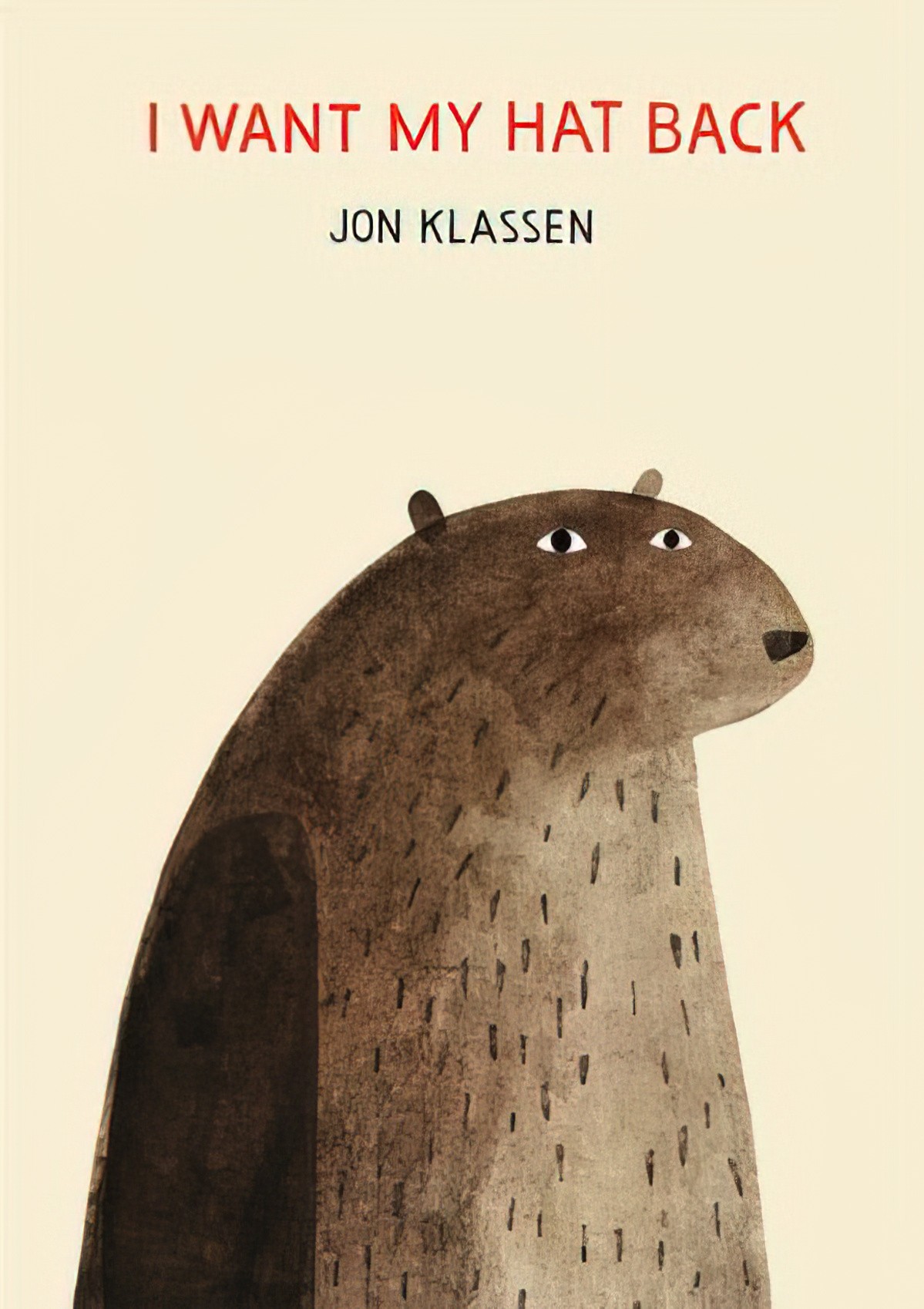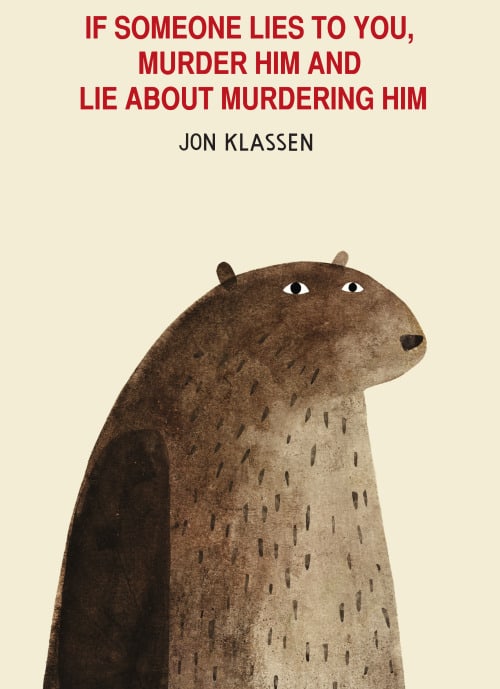I Want My Hat Back (2011) is one of a trilogy of books written and illustrated by Jon Klassen. The plots are not linked and the characters are different. But they all feature hats. The other two are This Is Not My Hat and We Found A Hat.
Holly Storck-Post at SLJ recommends these Jon Klassen books for use with older students in the classroom.
When I read an opinion piece last week on the decreasing length of picturebooks from Elizabeth Bluemle at Publishers Weekly, the books of Jon Klassen immediately sprang to mind, especially at this paragraph:
Why are we so bent on brief? Is it because children have shorter attention spans? (They do. We all do. Or do we?) Is it because parents are working harder than ever and are too tired to face long reading sessions at bedtime with their kids? Possibly. Or is it because we are currently experiencing a trend of short, meta, funny picture books that don’t unfold a story with characters so much as riff on a clever idea? That’s a teeny piece of it, surely.
Pandering to, or presuming shorter attention spans?
I Want My Hat Back is also interesting for the variety of reader responses who think that picture books must star morally upright characters; that children are vessels waiting to be filled with good examples, incapable of questioning moral grey areas.
STORY STRUCTURE OF I WANT MY HAT BACK
PARATEXT
A picture-book delight by a rising talent tells a cumulative tale with a mischievous twist.
The bear’s hat is gone, and he wants it back. Patiently and politely, he asks the animals he comes across, one by one, whether they have seen it. Each animal says no, some more elaborately than others. But just as the bear begins to despond, a deer comes by and asks a simple question that sparks the bear’s memory and renews his search with a vengeance. Told completely in dialogue, this delicious take on the classic repetitive tale plays out in sly illustrations laced with visual humor—and winks at the reader with a wry irreverence that will have kids of all ages thrilled to be in on the joke.
MARKETING COPY
If there’s an ur-Story to I Want My Hat Back, it’s Chicken Little. A doltish animal goes from character to character asking the same question, oblivious to the way the world really is. But between Chicken Little and I Want My Hat Back is Beatrix Potter’s Mrs. Tiggy-Winkle, in which the character of Lucie goes from animal to animal asking if they’ve seen her dropped handkerchief.
WHAT HAPPENS IN I WANT MY HAT BACK
A bear has lost his pointy red hat. He wanders morosely from page to page asking other animals if they have seen it. In his sorrow, he fails to notice that a rabbit happens to be wearing a pointy red hat. After lying on the ground for a while he has a revelation; he DOES know who has taken his hat!
The bear runs backwards through the book, and indeed gets his hat back. It’s a happy ending for the bear and the hat. The reader is left to surmise what has happened to the rabbit.
WONDERFULNESS
I Want My Hat Back is highly appreciated by my six-year-old. This is a very funny book — for those with a tolerance for slightly darker humour — and is best read in funny voices. The following review is typical:

Klassen not only breaks ‘the rules’ of what it takes to create a picture book for modern audiences; he seems to be starting a trend. What are the unwritten non-existent rules of picture books? Bright colours (because it’s thought kids only respond to bright colours), happy-lively characterisation (not morose); main characters who do the right thing despite everything.
I Want My Hat Back is almost a spoof on a large category of picture books which anthropomorphise bears and other wild animals to the point where they are borderline vegetarian. When we see picture book bears eat, they tend to be eating human food from plates, using knives and forks. Picture book bears do not go hunting. Adult co-readers know this, and I’m sure young readers know this deep down, but perhaps talking picture book bears who happen to eat talking rabbit is taboo. This book is written in such a way that should the book be read to a 3 year old who can’t yet cope with the reality of the food chain, that 3 year old can imagine instead that the rabbit delivered the hat back to the bear then ran away safely. But there is no such reassurance in the text.

NOTES ON THE ILLUSTRATION OF I WANT MY HAT BACK
Klassen works with inks, gouache and acrylics but everything is altered digitally afterwards. I wonder how few illustrators are completely avoiding the computer these days. Interestingly, Shaun Tan does the inverse, sorting out his composition on the computer then using that as a model to paint on canvas.
One thing that makes Klassen’s work distinctive is his texturing; he apparently creates the textures with paint, scans them in and keeps them in an unorganised folder on his computer. This makes me feel better about the general disorganisation of my own computer.
I do a lot of random texture samples on pieces of paper that will only find their homes once they’ve been scanned into the computer, and there’s no way to organize stuff like that once you’ve scanned it, so they are just everywhere around.
Textured overlays can make a big difference to an illustration, but tend to be one of those subtle additions that goes unnoticed by the reader of the story. Klassen’s are kind of ‘waterstained’ and ‘splattery’. This gives a sense of movement to images which otherwise look a little like collage, which is a more static-feeling medium.
STORY SPECS OF I WANT MY HAT BACK
Published in 2011
The Candlewick edition is 36 pages.
The FollettBound edition is 32 pages.
Marketed at level K-3
Even picturebooks have specific best-fits when it comes to age of audience. This from a GR reviewer, serving as a reminder that we shouldn’t stop buying picturebooks once children start school at 5 years of age:

This picture book has won a whole bunch of awards. Look at how half of them are European. I suspect this is partly because Europeans have a higher tolerance than American audiences for a children’s book character who does bad stuff:
- Deutscher Jugendliteraturpreis for Bilderbuch (2013)
- New York Times Best Illustrated Children’s Books (2011)
- Theodor Seuss Geisel Honor (2012)
- Selezionato Mostra Internazionale d’illustrazione per l’infanzia di Sarmede (2011)
COMPARE AND CONTRAST
Although the characters are different, this is very much the ‘on-land’ companion book to Klassen’s subsequent This Is Not My Hat. Sometimes when best-selling authors create a second book in similar style, the second one isn’t such a success. But both of these books are equally wonderful; buy both.
Contrast with The Tawny Scrawny Lion (A Golden Book), in which a lion is much happier after turning pescatarian.
Related post: Naturalistic Animal Behaviour In Picturebooks
The following year, Jon Klassen published This Is Not My Hat, which seems to be set in the same world as this book, but stars different characters. This is an interesting choice, because I suspect authors are often encouraged to create series based on the same character so that children will fall deeply in love with them and ask their parents to buy the plush toys.
WRITE YOUR OWN
A fun diversion is rewriting the titles of the picture books on your shelf. When you do this, you may be surprised to see that picture books have their own genre classifications. Jon Klassen seems to have (re?)invented the picturebook crime genre.
SEE ALSO
I Want My Hat Back, Don’t Ask Me Anymore Questions from We Read It Like This.


